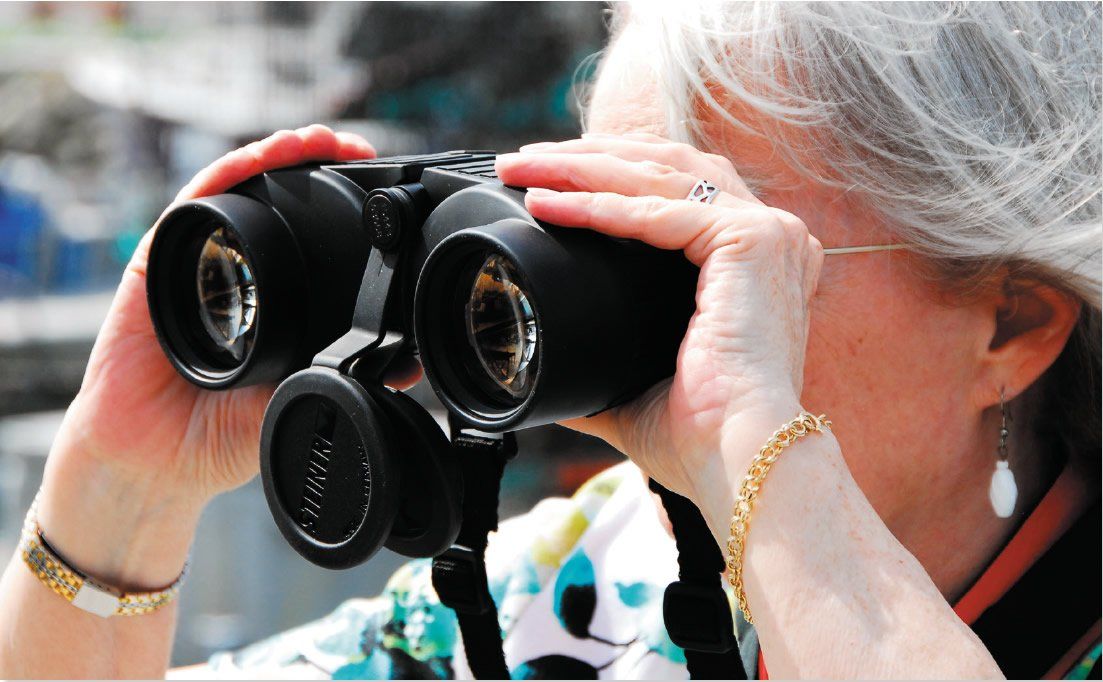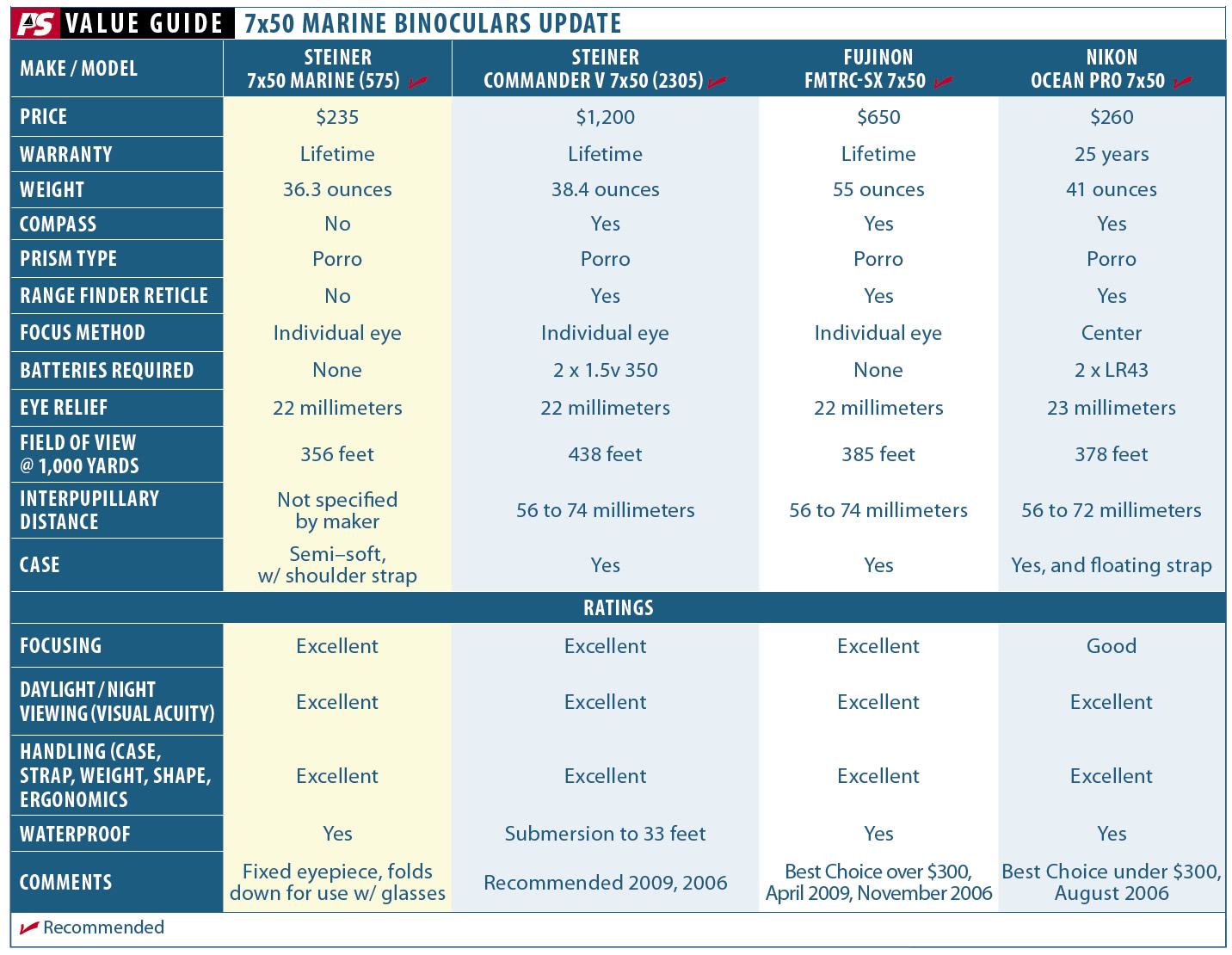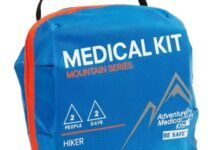Binoculars can be an expensive piece of kit, but they are essential safety gear for the mariner. Being able to clearly identify any object that comes within range of your boat-be it a ship, raft, flotsam, navigational marker, or a nearby shoreline-makes for a safer passage. Released in 2015, Steiner Optics’ Model 575, an affordably priced 7×50 marine binocular (without compass), prompted us to revisit our past binocular tests to see how it compared to our reigning top picks.

Photos by Ken Delavigne and courtesy of Steiner Optics
We’ve evaluated a range of binoculars in the last decade-from high-priced, image-stabilized binos (November 2007) and luxury optics (December 2009) to 7×50 marine binoculars priced above $300 (April 2009 and November 2006) and below $300 (August 2006). While the high-dollar products offer improved optical quality, durability, and engineering detail, good quality binoculars can be found at the lower end of the three-digit scale.
Binoculars with a 7x magnification and large, 50-millimeter front lenses have proven to be the ideal setup for viewing distant objects from aboard a boat, especially in low-light conditions and rough water. They have become the marine standard, and for the small-boat navigator, we recommend 7×50 binoculars with an internal compass.
Our past 7×50 favorites have included the Fujinon FMTRC-SX with compass ($650, Best Choice over $300), Nikon Ocean Pro ($260, Best Choice under $300, with compass), and the Steiner Commander V with compass ($1,200, Recommended among over $300 binos). Weve included the maker specs and our past test ratings for these products in the accompanying Value Guide for comparison to the new Steiner Marine 575 model. All, including the 575s, are waterproof and come with a case and carrying strap. For a rundown of other important binocular features, see Bino Lingo with the online version of this article.
Steiner Marine 7×50
Steiner has simply labeled its 575 model as the 7×50 Marine binocular. While the MSRP for this model is $330, Practical Sailor bought our test pair online for $235. We were curious to see what we would get at such a low price.
The 575 is clearly a Steiner in every tactile aspect, including individual focusing of the two barrels. It has the same lens glass, the same construction, and the same Heritage Warranty as Steiners higher-priced 7×50 models like the Commander V. It differs slightly in weight, field of view, and water resistance (waterproof instead of submersible).
Testers ran the 575 through similar trials as we have in past binocular reviews, including a static acuity test (reading 16-point Snellen type at 60 feet) to gauge sharpness. The 575s optics were impressive for this price point-what you would expect from such a reputable optics maker as Steiner; sharpness and visual acuity were high during both daytime and night-time viewing.
At 356 feet, the new Steiners field of view at 1,000 yards is slightly less than others we reviewed, but the difference would be negligible in use when compared to the Fujinon and Nikon. The Commander V has the largest field of view in this comparison (438 feet).
Testers rated the 575s as Excellent for handling, noting their light weight and ergonomic shape, and that the eyepieces fold down for use with glasses.
The 575s, like the Commander V and Fujinon binos, use individual focusing (IF), rather than center focusing (CF), which is what the Nikon Ocean Pro uses. With IF, each barrel of the binocular must be adjusted separately; CF means a single adjustment changes both barrels. For nautical use, where everything (including you) is moving, IF makes focusing easier.
Steiner advises users to set the binoculars in advance for their personal zone of acceptably sharp focus, and suggests writing these settings down. We recommend developing and recording a number of settings for various situations (offshore, daysailing, harbor transit, bay racing). We wish Steiner had marked the rings with unambiguous settings like 0 to 10 instead of undistinguished vertical lines; this would make changing to a new predefined setting much quicker.
Since users don’t need to continually update focus with IF binos as they would with CF models, we expect the focus rings to have some friction to avoid accidental turning, but testers noted that the 575s rings were a bit too stiff. Thinking this may be resolved with more use, we did not ding the 575s overall Excellent focusing rating for this slight nit-pick.

Bottom line: At a quarter of the price of the Commander V and less than half that of the FMTRC-SX, the Steiner 7×50 Marine has much to offer, especially in view of its warranty. (For the life of the product, Steiner will repair or replace it if it becomes damaged or defective; warranty is transferrable.) We Recommend it in the under $300 category.
Conclusion
Steiners 575 offers the same excellent optical performance we found in other models weve rated highly. When compared to its closest price-point competitor in this report, the Nikon Ocean Pro, testers prefer the 575s individual-focus feature and warranty. If youre looking for an entry-level 7×50 binocular without a compass that covers all the basics and has great optics, we can Recommend the Steiner 575; those who want a compass will find that the Nikon is still a good choice in for the price. If you have the budget, however, and are looking for superb optics and a more rugged product, we Recommend the Fujinon FMTRC-SX or Steiner Commander V.







































In your review you missed the most important feature – stabilization. My biggest problem is not field of vision or any other stuff, but constant shaking of the boat, which prevents me from reading e.g. buoy number, or sail number, or vessel name until I am close enough.
Alex,
We’ve done a couple of reviews of IS binoculars. Also Infra red. Here is a link to the last IS review — yes it is old, and we need to update it. Be sure to read the Dec. 2006 article as well (there is alink in the text of the review cited here). https://www.practical-sailor.com/personal-gear-apparel/nikon-and-fujinon-go-head-to-head-in-practical-sailors-test-of-image-stabilized-binoculars